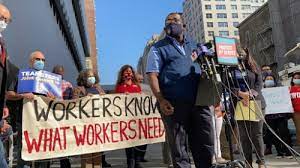In a recent article by Councilwoman Amanda Farias and Annie Garneva calling for the reinventing of New York’s economy and workforce as a result of the pandemic, a significant aspect of their call for an economic reinvention revolves around workforce development. There is no doubt the cities workforce is central to the vibrancy that makes New York the world class city it is. There is also no doubt about the need for vibrant career development to enable people to enter careers of that can provide upward mobility.
Nonetheless, while it is appropriate to discuss the need for enhanced workforce development programs and jobs pipelines it must be remembered that job training programs are in abundance in the city. From the JTPA programs during the 1980’s and 90’s to today’s various programs, NewYork City is not suffering from a dearth of job training programs.
The call for reinventing systems and thinking about new normals as a result of the aftermath of the pandemic has become commonplace but it is empty rhetoric without a serious conversation about how workers can reap the fruits of their labor.
While NYC Mayor Eric Adam’s Blueprint to Rebuild, Renew, Reinvent NYC may be a necessary start, like most administrations it falls way short of creative and strategic thinking about how to create an economy where the fruits of a vibrant economy are distributed with greater equality than it has in recent decades. While the Mayor’s plan calls for important quality of life issues such as safety and economic investment, it does very little to ensure that New York’s workforce will share in the economic resurgence of New York’s economy.
Whether it’s the cost of housing, transportation or even to enjoy the many cultural activities of the city it is no secret that from a financial perspective New York is a difficult place to live and to raise a family.
Even before the political and media emphasis on inflation, New Yorkers were struggling to maintain a lifestyle in New York. Recent studies reported that average rent has reached $4000 per month and in Manhattan alone $5000 per month.
Workforce development is a critical aspect of the economic life of New York. Unfortunately it is not enough to create meaningful upward mobility for the average New Yorker.
On the issue of housing there has been very little substantive public discussion about creating a strategy that leads to affordable housing for the working class. In fact not since the advent of organizations such as East Brooklyn Congregations and South Bronx Churches through their strategy of Nehemiah Homes has the political class been confronted with the idea of what is affordable for the average New Yorker.
Average New Yorkers bore the brunt of the Covid pandemic but it is doubtful they will reap the financial benefits of a reinvigorated economy. Candidate Eric Adams campaigned as a pro-business Mayor. In of itself that is not negative however it does suggest that his primary focus will be to ensure the business community will be primary beneficiary of his policies not the average New Yorker. For that to happen it will take a concerted effort led by community based organizations, including faith based institutions who tend to be ignored by secular CBO’s.
The first step is the creation of a clear and specific agenda that focuses on items that enables the working class to reap the fruits of their labor including raising a family. Politicos have a gift for declaring the problem in aspirational tones but are often reluctant to name specific policies they will support and fight for.
Some of the agenda items can include a 10 year plan that ties housing cost to after tax income. While the mayor’s plan calls for 5 billion dollars over the next 10 years it is clearly not enough nor is it defined in a manner designed to benefit those most in need of affordable housing. Included in this policy should be a strategy that improves the quality of life within public housing which consistently has the highest rate of crime.
As wealth distribution is normally tied to tax policies, Mayor Adams could support the recently reintroduced proposal for a New York stock transfer tax which is presently opposed by the business community. This could lead to a dedicated revenue source that could subsidize affordable housing or other strategies to benefit the working and middle class of New York. While the business community has opposed this tax
Organizations could support a credit rating moratorium which would call for a significant decrease in the time for negative credit to be removed from credit reports.
When it comes to workforce development Mayor Adam’s can revisit former Mayor DeBlasio’s plan calling for companies that receive subsidies would have to hire a percentage of their workforce from the present pipelines.
These are just a few items which could be included on an agenda to help workers reap the fruits of their labor.
Workforce development is a critical aspect but without strategies to reap the fruits of their labor, workers will continue to be like the hamster on a running wheel.
Dickens talked about a tale of two cities but New York is a tale of many cities. It’s a city where people are doing extremely well, a city where people are doing extremely bad and it’s a city where people are barely treading water.
If the Mayor is serious about reinvigorating the economy of the city he has an opportunity to implement policies that would not just benefit the investor class but also the workers who are deemed so essential during the pandemic.
Time will tell how essential and important these workers really are. If history is prologue New York will see a new gilded age with workers being served aspirational platitudes by Mayor Adams while the cities wealthy class reap the financial fruits of their investments.
